Hobby Boss 1/72 Dewoitine D.520
|
KIT: |
Hobby Boss 1/72 Dewoitine D.520 |
|
KIT #: |
80237 |
|
PRICE: |
$9.00 MSRP |
|
DECALS: |
Two Options |
|
REVIEWER: |
Brian
Baker |
|
NOTES: |
|
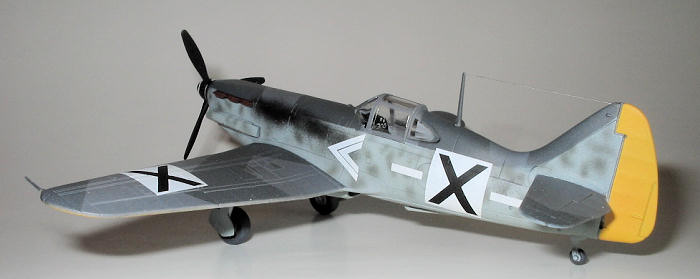
The Dewoitine D.520 was designed in
the late thirties in an attempt by the French to catch up with the apparent lead
of Britain
and Germany in
fighter development, and was the only really modern fighter in the Armee de
l’Aire inventory when war finally broke out in 1939.
One factor in its late introduction was the
nationalization in 1936 of the French Aircraft industry, and the original
Dewoitine firm’s incorporation into the nationalized French aviation industry.
Emile Dewoitine and several other engineers and designers left the firm and
started a design bureau, and after several prototypes, developed the D.520,
which was certainly on a par with the Hurricane although slightly lower in
performance than the Spitfire and Messerschmitt Bf-109E, partially due to its
lower engine power. Their new firm was later nationalized, but development of
their aircraft was slowed because the Air Ministry had already decided to adopt
the Morane MS.406 a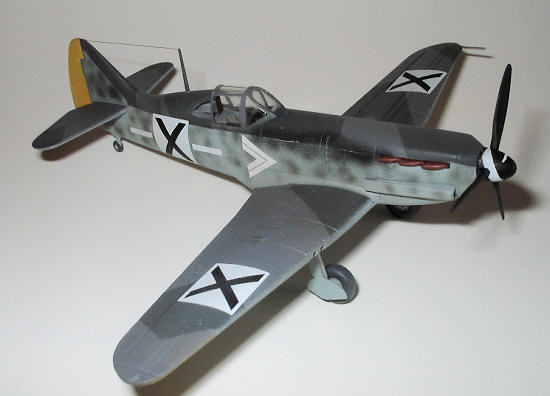 s its standard fighter, so the D.520 had a lower priority.
s its standard fighter, so the D.520 had a lower priority.
Eventually, French
authorities saw that the D.520 was a better airplane, and in late 1939, large
orders were placed, with a target delivery rate of 200 aircraft per month. In
addition, fighters were ordered from the U.S.,
including export versions of the Curtiss P-36A.
The
first production D.520 flew in October, 1939, and deliveries were slow due to
shortages of critical components.
By the time of the German offensive in May, 1940,
246 D.520’s had been produced, with only 79 accepted into service.
During the Battle of France, additional units were
converted to the D.520, but the type was not influential in the outcome of the
battle.
D.520 units claimed 108 confirmed and 39 probable victories
at a cost of 106 aircraft, 26 in air combat and 80 to other causes.
After the Armistice,
the Vichy
government was allowed to maintain a limited air force, and D.520’s were used by
those units that remained intact.
Throughout 1940 and 1941, these units operated
D.520’s in unoccupied France
and Algeria.
In November, 1942, the Allies landed in French
North Africa, and French D.520 units strongly resisted, losing 35 aircraft to
U.S.
and British fighters. The Germans responded by invading unoccupied
France, taking over the D.50’s that remained in
France.
These aircraft were used by the Luftwaffe as
fighter trainers, or passed on to other allies, including
Italy
and Bulgaria.
Some Luftwaffe survivors recaptured by the French were used against the Germans
in areas cut off by the allied advance, and after the war, the surviving
aircraft were reincorporated into the postwar air force, some being converted to
two seat trainers. Some of these lasted until 1953. Four aircraft survived into
the eighties, and three have been placed on display in various museums, while
the fourth, which was flown regularly, was damaged beyond repair in a fatal
crash in 1986.
Hobby Boss, a Chinese firm, has
introduced a line of “quick-build” kits in 1/72 scale, mainly depicting World
War II fighters.
This is one of the more obscure types they have
offered, and if you can ignore the simplicity and lack of details, you can build
an acceptab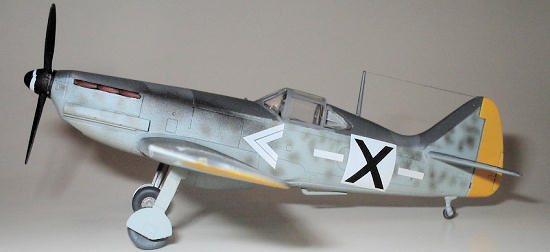 le model from almost any of these kits. They all have their faults,
of course, but they are designed for youngsters with little experience, and when
assembled, produce a model that with a little extra effort, could compare
favorably with some of the earlier offerings from Airfix and even Hasegawa.
Besides, they are quick and they are fun.
le model from almost any of these kits. They all have their faults,
of course, but they are designed for youngsters with little experience, and when
assembled, produce a model that with a little extra effort, could compare
favorably with some of the earlier offerings from Airfix and even Hasegawa.
Besides, they are quick and they are fun.
The kit consists of a main
fuselage, a lower section that includes the entire wing, elevators, exhaust
stacks and shields, a radiator scoop, landing gear, tailwheel,
propeller, and canopy.
There is only a little flash, and this is easily
removed.
Parts snap into place, and I believe that the kit is
designed to be assembled without any kind of solvent or glue. If the parts are
assembled correctly, there is no way that the wing or tailplane can be out of
alignment. They are as “idiotproof” as a kit can be.
This kit is the equivalent of
the model railroading ‘shake the box” kit.
Everything snaps into place,
although serious modelers will want to use some solvent glue.
The wing fits into the bottom
of the fuselage, and requires only a little filler at the re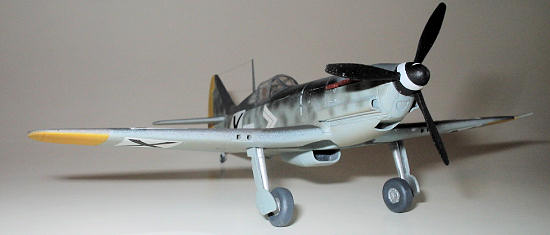 ar.
Fit is excellent.
The horizontals snap into
place, and the radio mast fits perfectly in the aft portion of the fuselage.
The landing gear consists of
wheels, struts, and doors, like any other kit. The radiator is well done,
and snaps into place under the fuselage.
The canopy snaps into place
easily, and is easy to mask and paint.
The propeller assembly consists
of the prop, two alternate spinners (although I don’t know why, as both
planes depicted in the painting guide have the shorter spinner), a long
shaft, a spinner place, a long wire shaft, and an end cap.
This is probably the most
complicated part of the kit. It is intended to be pushed into the nose after
assembly and painting, and the prop will turn but it won’t spin like normal
kit assemblies.
ar.
Fit is excellent.
The horizontals snap into
place, and the radio mast fits perfectly in the aft portion of the fuselage.
The landing gear consists of
wheels, struts, and doors, like any other kit. The radiator is well done,
and snaps into place under the fuselage.
The canopy snaps into place
easily, and is easy to mask and paint.
The propeller assembly consists
of the prop, two alternate spinners (although I don’t know why, as both
planes depicted in the painting guide have the shorter spinner), a long
shaft, a spinner place, a long wire shaft, and an end cap.
This is probably the most
complicated part of the kit. It is intended to be pushed into the nose after
assembly and painting, and the prop will turn but it won’t spin like normal
kit assemblies.
As a quick build kit, it is
childishly simple, and any kid above the age of six should be able to get
one together if daddy does the trimming of the parts from the sprues.
And the end result for a
serious modeler isn’t bad either.
I haven’t built the Hasegawa
kit, but I suspect that the completed model would look OK next to it.
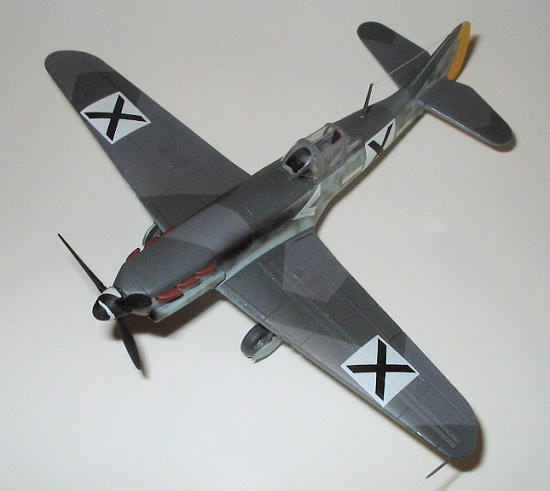 Decals are provided for two aircraft,
a D.520 of GC1/3 during the battle of France,
and a D.520 in Vichy French markings, complete with red and yellow nose and tail
markings.
Of course, I chose to do one in Bulgarian markings, as I
already had Heller models of the other two color schemes.
The decals go on easily, although they are pretty
glossy and need to be trimmed. I elected not to use them. I have used other
decals from Hobby Boss kits, and they seem to work OK.
Decals are provided for two aircraft,
a D.520 of GC1/3 during the battle of France,
and a D.520 in Vichy French markings, complete with red and yellow nose and tail
markings.
Of course, I chose to do one in Bulgarian markings, as I
already had Heller models of the other two color schemes.
The decals go on easily, although they are pretty
glossy and need to be trimmed. I elected not to use them. I have used other
decals from Hobby Boss kits, and they seem to work OK.
This kit would be a good starter for a
kid interested in modeling, and wanting a quick-build.
It is robust enough to survive, sans landing gear
and prop, for a while as a toy.
Of course, it can be built into an acceptable model
by the serious modeler, and with a little detailing,
looks
comparable to more sophisticated models.
Try several of these kits.
They are quick, fun, and inexpensive.
Brian
Baker
May 2008
If you would like your product reviewed fairly and quickly, please
contact
me or see other details in the
Note to
Contributors.
Back to the Main Page
Back to the Review Index Page


 s its standard fighter, so the D.520 had a lower priority.
s its standard fighter, so the D.520 had a lower priority. le model from almost any of these kits. They all have their faults,
of course, but they are designed for youngsters with little experience, and when
assembled, produce a model that with a little extra effort, could compare
favorably with some of the earlier offerings from Airfix and even Hasegawa.
Besides, they are quick and they are fun.
le model from almost any of these kits. They all have their faults,
of course, but they are designed for youngsters with little experience, and when
assembled, produce a model that with a little extra effort, could compare
favorably with some of the earlier offerings from Airfix and even Hasegawa.
Besides, they are quick and they are fun. ar.
Fit is excellent.
The horizontals snap into
place, and the radio mast fits perfectly in the aft portion of the fuselage.
The landing gear consists of
wheels, struts, and doors, like any other kit. The radiator is well done,
and snaps into place under the fuselage.
The canopy snaps into place
easily, and is easy to mask and paint.
The propeller assembly consists
of the prop, two alternate spinners (although I don’t know why, as both
planes depicted in the painting guide have the shorter spinner), a long
shaft, a spinner place, a long wire shaft, and an end cap.
This is probably the most
complicated part of the kit. It is intended to be pushed into the nose after
assembly and painting, and the prop will turn but it won’t spin like normal
kit assemblies.
ar.
Fit is excellent.
The horizontals snap into
place, and the radio mast fits perfectly in the aft portion of the fuselage.
The landing gear consists of
wheels, struts, and doors, like any other kit. The radiator is well done,
and snaps into place under the fuselage.
The canopy snaps into place
easily, and is easy to mask and paint.
The propeller assembly consists
of the prop, two alternate spinners (although I don’t know why, as both
planes depicted in the painting guide have the shorter spinner), a long
shaft, a spinner place, a long wire shaft, and an end cap.
This is probably the most
complicated part of the kit. It is intended to be pushed into the nose after
assembly and painting, and the prop will turn but it won’t spin like normal
kit assemblies. Decals are provided for two aircraft,
a D.520 of GC1/3 during the battle of
Decals are provided for two aircraft,
a D.520 of GC1/3 during the battle of